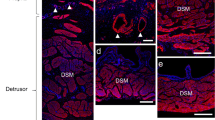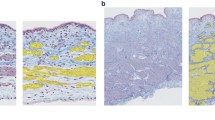Abstract
Urinary bladder function is known to mature during fetal and postnatal development, including changes in neurotransmitter regulation of detrusor contraction. However, only few experimental data are available about muscarinic receptor antagonist function in the urinary bladder from young animals. In the present study, we compare the muscarinic receptor-mediated contractions in juvenile and adult porcine detrusor and the effects of antimuscarinic compounds. Urinary bladders from young (8–12 weeks; 12- to 35-kg body weight) and mature pigs (>40 weeks; >100 kg) were compared. Muscarinic receptor expression was assessed by real time polymerase chain reaction and radioligand binding. Muscle contraction was measured with a force transducer; L-type Ca2+ currents (I Ca,L) of isolated detrusor myocytes were recorded with standard voltage clamp technique. Juvenile and adult detrusor expressed similar quantities of the messenger RNA of M2 and M3 receptors. The number of [3H]QNB-binding sites and their affinity for the radioligand were also similar between juvenile and adult detrusor. In contrast, maximum contractile responses to the muscarinic receptor agonist carbachol were slightly larger in juvenile than adult bladders. On the other hand, carbachol was slightly less potent in juvenile than in adult tissue. The M3 antagonist DAU 5884 and the spasmolytic drug propiverine inhibited contractile responses with comparable efficacies and potencies in juvenile and adult tissue. I Ca,L was somewhat smaller in juvenile than in adult cells. Taken together, these data suggest that expression and function of M2 and M3 receptors are similar in the detrusor of juvenile and mature pigs. Therefore, similar responses to antimuscarinic compounds could be expected in young and adult patients.






Similar content being viewed by others
References
Abrams P, Andersson KE, Buccafusco JJ, Chapple C, deGroat WC, Fryer AD, Kay G, Laties A, Nathanson NM, Pasricha PJ, Wein AJ (2006) Muscarinic receptors: their distribution and function in body systems, and the implications for treating overactive bladder. Br J Pharmacol 148:565–578
Andersson KE, Arner A (2004) Urinary bladder contraction and relaxation: physiology and pathophysiology. Physiol Rev 84:935–986
Andersson KE, Yoshida M (2003) Antimuscarinics and the overactive detrusor—which is the main mechanism of action? Eur Urol 43:1–5
Arunlakshana O, Schild, (1959) Br J Pharmacol 14:48–58
Brandes SB, Ruggieri MR (1995) Adv Exp Med Biol 385:241–249
Chess-Williams R, Chapple CR, Yamanishi T, Yasuda K, Sellers DJ (2001) The minor population of M3-receptors mediate contraction of human detrusor muscle in vitro. J Auton Pharmacol 21:243–248
Christ GJ, Hodge S (2006) Molecular mechanisms of detrusor and corporal myocyte contraction: identifying targets for pharmacotherapy of bladder and erectile dysfunction. Br J Pharmacol 147:S41–S55
Doods HN, Willim KD, Boddeke HWGM, Entzeroth M (1993) Characterization of muscarinic receptors in guinea-pig uterus. Eur J Pharmacol 250:223–230
Fetscher C, Fleichmann M, Schmidt M, Krege S, Michel MC (2002) M3 muscarinic receptors mediate contraction of human urinary bladder. Br J Pharmacol 136:641–644
Fry CH, Skennerton D, Wood D, Wu C (2002) The cellular basis of contraction in human detrusor smooth muscle from patients with stable and unstable bladders. Urology 59:3–12
Gosens R, Nelemans SA, Groote Bromhaar MM, McKay S, Zaagsma J, Meurs H (2003) Muscarinic M3-receptors mediate cholinergic synergism of mitogenesis in airway smooth muscle. Am J Respir Cell Mol Biol 28:257–262
Graf EM, Bock M, Heubach JF, Zahanich I, Boxberger S, Richter W, Schultz JH, Ravens U (2005) Tissue distribution of a human Cav1.2 α1 subunit splice variant with 75 bp insertion. Cell Calcium 38:11–21
Grigoleit U, Murtz G, Laschke S, Schuldt M, Goepel M, Kramer G, Stohrer M (2006) Efficacy, tolerability and safety of propiverine hydrochloride in children and adolescents with congenital or traumatic neurogenic detrusor overactivity—a retrospective study. Eur Urol 49:1114–1120
Hegde SS (2006) Muscarinic receptors in the bladder: from basic research to therapeutics. Br J Pharmacol 147:S80–S87
Lazzeri M (2006) More urological clinical trials in children are needed. Eur Urol 50:662–663
Lee JG, Coplen D, Macarak E, Wein AJ, Levin RM (1994) Comparative studies on the ontogeny and autonomic responses of the fetal calf bladder at different stages of development: involvement of nitric oxide on field stimulated relaxation. J Urol 151:1096–1101
Levin RM, Malkowicz SB, Jacobowitz D, Wein AJ (1981) The ontogeny of the autonomic innervation and contractile response of the rabbit urinary bladder. J Pharmacol Exp Ther 219:250–257
Levin RM, Macarak E, Howard P, Horan P, Kogan BA (2001) The response of fetal sheep bladder tissue to partial outlet obstruction. J Urol 166:1156–1160
Longhurst P (2004) Developmental aspects of bladder function. Scand J Urol Nephrol Suppl 215:11–19
Madersbacher H, Mürtz G (2001) Efficacy, tolerability and safety profile of propiverine in the treatment of the overactive bladder (non-neurogenic and neurogenic). World J Urol 19:324–335
Marschall-Kehrel D, Persson-de Geeter C, Stehr M, Simson G, Matschke U, Veticka J, Ionescu S, Sillén U, Martincok D, Radmayr C, Nijman J, Schmidt C (2007) Study design As the main predictor for good outcome in a randomised placebo-controlled multicentre trial in children suffering from overactive bladder and urinary incontinence. Neurourol Urodyn 26:657–658
Masters JG, Neal DE, Gillespie JI (1999) The contribution of intracellular Ca2+ release to the contraction in human bladder smooth muscle. Br J Pharmacol 127:996–1002
Nijman RJ (2004) Role of antimuscarinics in the treatment of nonneurogenic daytime urinary incontinence in children. Urology 63:45–50
O’Reilly BA, Kosaka AH, Chang TK, Ford APDW, Popert R, Rymer JM, McMahon SB (2001) A quantitative analysis of purinoceptor expression in human fetal and adult bladders. J Urol 165:1730–1734
Ouslander JG (2004) Management of overactive bladder. N Engl J Med 350:786–799
Rivera L, Brading AF (2006) The role of Ca2+ influx and intracellular Ca2+ release in the muscarinic-mediated contraction of mammalian urinary bladder smooth muscle. BJU Int 98:868–875
Roffel AF, Elzinga CR, Zaagsma J (1993) Cholinergic contraction of the guinea pig lung strip is mediated by muscarinic M2-like receptors. Eur J Pharmacol 250:267–279
Schneider T, Fetscher C, Krege S, Michel MC (2004) J Pharmacol Exp Ther 309:1148–1153
Schneider T, Hein P, Michel-Reher MB, Michel MC (2005) Effects of ageing on muscarinic receptor subtypes and function in rat urinary bladder. Naunyn Schmiedeberg’s Arch Pharmacol 372:71–78
Schulte-Baukloh H, Murtz G, Henne T, Michael T, Miller K, Knispel HH (2006) Urodynamic effects of propiverine hydrochloride in children with neurogenic detrusor overactivity: a prospective analysis. BJU Int 97:355–358
Schultz-Lampel D (2006) The overactive bladder during childhood. When and how should it be treated? Urologe A 45:841–846
Tugay M, Yildiz F, Utkan T, Gacar N, Ulak G, Eden F (2003) Age-related smooth muscle reactivity changes in the rat bladder: an in vitro study. Pharmacol Res 48:329–334
Tokuno H, Chowdhury JU, Tomita T (1993) Inhibitory effects of propiverine on rat and guinea-pig urinary bladder muscle. Naunyn Schmiedeberg’s Arch Pharmacol 348:659–662
Uchida S, Kurosawa S, Fujino Oki T, Kato Y, Nanri M, Yoshida K, Yamada S (2007) Binding activities by propiverine and its N-oxide metabolites of L-type calcium channel antagonist receptors in the rat bladder and brain. Life Sci 80:2454–2460
Wegener JW, Schulla V, Lee TS, Koller A, Feil S, Feil R, Kleppisch T, Klugbauer N, Moosmang S, Welling A, Hofmann F (2004) FASEB J 18:1159–1161
Wuest M, Braeter M, Schoeberl C, Ravens U (2005) Juvenile pig detrusor: effects of propiverine and three of its metabolites. Eur J Pharmacol 524:145–148
Wuest M, Hecht J, Christ T, Braeter M, Schoeberl C, Hakenberg OW, Wirth MP, Ravens U (2005) Pharmacodynamics of propiverine and three of its main metabolites on detrusor contraction. Br J Pharmacol 145:608–619
Wuest M, Hiller N, Braeter M, Hakenberg OW, Wirth MP, Ravens U (2007) Contribution of Ca2+. influx to carbachol-induced detrusor contraction is different in human urinary bladder compared to pig and mouse. Eur J Pharmacol 565:180–189
Wust M, Averbeck B, Reif S, Brater M, Ravens U (2002) Different. Eur J Pharmacol 454:59–69
Yamanishi T, Chapple CR, Yasuda K, Chess-Williams R (2000) The role of M2 muscarinic receptors in mediating contraction of the pig urinary bladder in vitro. Br J Pharmacol 131:1482–1488
Zderic SA, Hypolite J, Duckett JW, Snyder HM, Wein AJ, Levin RM (1991) Development aspects of bladder contractile function: sensitivity to extracelluar calcium. Pharmacology 43:61–68
Zderic SA, Sillen U, Liu GH, Liu GH, Snyder HM 3rd, Duckett JW, Gong C, Levin RM (1994) Developmental aspects of excitation contraction coupling of rabbit bladder smooth muscle. J Urol 152:679–681
Acknowledgment
The authors would like to thank Sabine Kirsch and Martina Michel-Reher for their technical assistance.
Author information
Authors and Affiliations
Corresponding author
Rights and permissions
About this article
Cite this article
Wuest, M., Eichhorn, B., Braeter, M. et al. Muscarinic receptor expression and receptor-mediated detrusor contraction: comparison of juvenile and adult porcine tissue. Pflugers Arch - Eur J Physiol 456, 349–358 (2008). https://doi.org/10.1007/s00424-007-0407-z
Received:
Revised:
Accepted:
Published:
Issue Date:
DOI: https://doi.org/10.1007/s00424-007-0407-z




